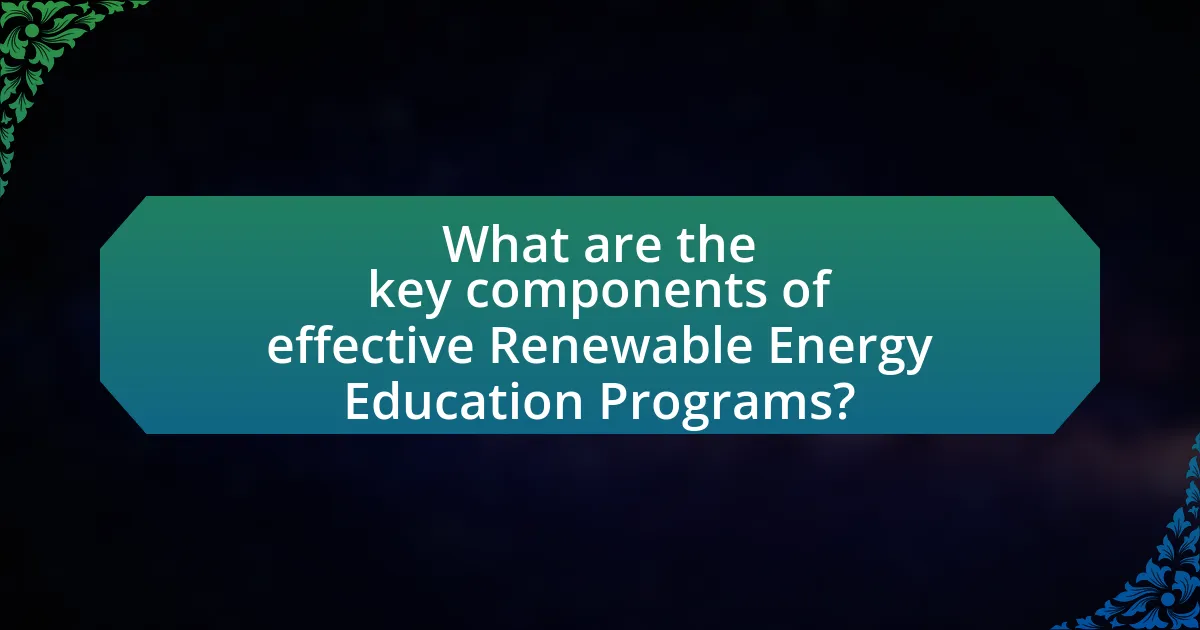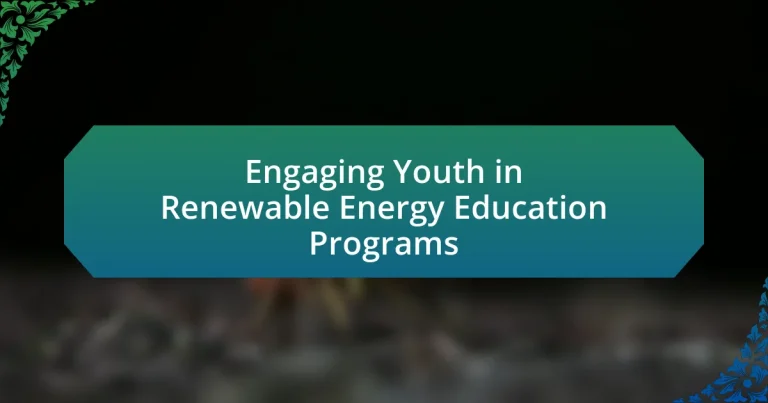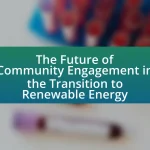Renewable Energy Education Programs for Youth are structured initiatives aimed at teaching young individuals about renewable energy sources, their benefits, and practical applications. These programs utilize hands-on activities, workshops, and interactive learning experiences to engage students in topics such as solar, wind, and hydroelectric power. Research highlights the importance of early exposure to renewable energy concepts in fostering interest in STEM fields and environmental stewardship. The article explores how these programs effectively engage youth, the challenges they face, and the strategies for enhancing participation, including community involvement and partnerships with industry professionals. Additionally, it discusses the impact of youth engagement on future energy solutions and environmental awareness.

What are Renewable Energy Education Programs for Youth?
Renewable Energy Education Programs for Youth are structured initiatives designed to teach young people about renewable energy sources, their benefits, and their applications. These programs often include hands-on activities, workshops, and curriculum-based learning that cover topics such as solar, wind, and hydroelectric power. For instance, organizations like the National Renewable Energy Laboratory (NREL) and various educational institutions have developed programs that engage students through interactive projects and real-world applications, fostering a deeper understanding of sustainable energy practices. Research indicates that early exposure to renewable energy concepts can significantly influence youth’s interest in STEM fields and environmental stewardship, promoting a generation that is more informed about energy sustainability.
How do these programs engage young people?
These programs engage young people by incorporating hands-on activities, interactive learning experiences, and real-world applications of renewable energy concepts. For instance, participants often work on projects that involve building solar panels or wind turbines, which fosters practical skills and enhances understanding of renewable technologies. Research indicates that experiential learning significantly increases retention rates and interest in STEM fields among youth, as evidenced by a study published in the Journal of Environmental Education, which found that students involved in hands-on renewable energy projects showed a 40% increase in engagement compared to traditional classroom settings.
What methods are used to attract youth to renewable energy topics?
Interactive workshops and hands-on projects are effective methods used to attract youth to renewable energy topics. These approaches engage young people by allowing them to participate actively in learning experiences, such as building solar panels or conducting energy audits. Research indicates that experiential learning significantly enhances interest and retention in STEM fields, including renewable energy. For instance, a study by the National Renewable Energy Laboratory found that students who participated in hands-on renewable energy projects showed a 40% increase in their understanding of energy concepts compared to traditional classroom instruction.
How do hands-on activities enhance learning in these programs?
Hands-on activities enhance learning in renewable energy education programs by providing practical experience that reinforces theoretical concepts. Engaging in real-world tasks allows students to apply knowledge, fostering deeper understanding and retention. Research indicates that experiential learning can improve problem-solving skills and critical thinking, essential for grasping complex subjects like renewable energy. For instance, a study by Kolb (1984) emphasizes that active participation in learning processes leads to better outcomes compared to passive learning methods. This evidence supports the effectiveness of hands-on activities in enhancing educational experiences in these programs.
Why is youth engagement in renewable energy important?
Youth engagement in renewable energy is crucial because it fosters innovation and drives the transition to sustainable energy solutions. Engaging young people encourages them to contribute fresh ideas and perspectives, which are essential for addressing the complex challenges of climate change and energy sustainability. According to a report by the International Renewable Energy Agency, involving youth in renewable energy initiatives can lead to increased awareness and advocacy for clean energy technologies, ultimately influencing policy and market trends. This engagement not only empowers the younger generation but also ensures that future energy systems are designed with their needs and values in mind.
What impact does youth involvement have on future energy solutions?
Youth involvement significantly enhances future energy solutions by fostering innovation and promoting sustainable practices. Engaged youth bring fresh perspectives and creativity to energy challenges, often leading to the development of novel technologies and approaches. For instance, initiatives like the Solar Youth program have demonstrated that when young people participate in renewable energy projects, they not only gain valuable skills but also contribute to community awareness and adoption of sustainable energy practices. Research indicates that youth-led projects can increase local engagement in renewable energy by up to 30%, showcasing their potential to drive change in energy consumption patterns and policy advocacy.
How does engaging youth contribute to environmental awareness?
Engaging youth significantly contributes to environmental awareness by fostering a sense of responsibility and empowerment regarding ecological issues. When young individuals participate in environmental education programs, they gain knowledge about sustainability, renewable energy, and the impact of human activities on the planet. Research indicates that youth involvement in such programs leads to increased environmental literacy, as evidenced by a study published in the Journal of Environmental Education, which found that students who engaged in hands-on renewable energy projects demonstrated a 30% increase in their understanding of environmental concepts. This active participation not only enhances their awareness but also encourages them to advocate for sustainable practices within their communities, creating a ripple effect that promotes broader societal change.

What are the key components of effective Renewable Energy Education Programs?
Effective Renewable Energy Education Programs consist of comprehensive curriculum design, hands-on learning experiences, community engagement, and access to current technologies. Comprehensive curriculum design ensures that students understand the principles of renewable energy, including solar, wind, and hydroelectric systems, while hands-on learning experiences, such as building solar panels or wind turbines, enhance practical skills and reinforce theoretical knowledge. Community engagement fosters collaboration with local organizations and stakeholders, providing real-world context and support for projects. Access to current technologies, such as simulation software and renewable energy tools, equips students with the skills necessary for future careers in the field. These components collectively create an impactful educational experience that prepares youth for participation in the renewable energy sector.
What types of content are included in these programs?
The types of content included in renewable energy education programs for youth typically encompass interactive workshops, hands-on activities, multimedia presentations, and project-based learning experiences. These programs often feature curriculum components that cover topics such as solar energy, wind power, energy efficiency, and sustainability practices. For instance, a study by the National Renewable Energy Laboratory highlights that engaging youth through practical applications and real-world problem-solving enhances their understanding of renewable energy concepts.
How do theoretical lessons complement practical experiences?
Theoretical lessons complement practical experiences by providing foundational knowledge that enhances understanding and application in real-world scenarios. For instance, in renewable energy education programs, theoretical lessons on energy principles, such as the laws of thermodynamics and energy conversion, equip students with the necessary context to effectively engage in hands-on projects like solar panel installation or wind turbine assembly. This integration of theory and practice fosters critical thinking and problem-solving skills, as students can apply theoretical concepts to troubleshoot and optimize practical tasks, thereby reinforcing their learning and preparing them for future challenges in the renewable energy sector.
What role do guest speakers and industry professionals play?
Guest speakers and industry professionals play a crucial role in engaging youth in renewable energy education programs by providing real-world insights and expertise. Their participation enhances the learning experience by bridging the gap between theoretical knowledge and practical application, making the subject matter more relatable and inspiring for students. For instance, guest speakers can share their experiences in renewable energy projects, illustrating the impact of this field on society and the environment. This firsthand knowledge not only motivates students but also helps them understand potential career paths in renewable energy, thereby fostering interest and involvement in the sector.
How are these programs structured to maximize impact?
These programs are structured to maximize impact by incorporating hands-on learning experiences, community involvement, and interdisciplinary approaches. Hands-on learning allows youth to engage directly with renewable energy technologies, fostering practical skills and deeper understanding. Community involvement ensures that programs are relevant to local contexts, enhancing engagement and support from families and local organizations. Interdisciplinary approaches integrate science, technology, engineering, and mathematics (STEM) education, which has been shown to improve student interest and achievement in these fields. Research indicates that programs designed with these elements can lead to increased knowledge retention and a greater likelihood of pursuing careers in renewable energy sectors.
What is the typical duration and format of these programs?
The typical duration of renewable energy education programs for youth ranges from a few weeks to several months, depending on the program’s structure and objectives. These programs often utilize a combination of formats, including hands-on workshops, online courses, and interactive seminars, to engage participants effectively. For instance, a study by the National Renewable Energy Laboratory indicates that programs lasting 6 to 12 weeks with a mix of in-person and virtual components tend to enhance learning outcomes and participant engagement.
How is progress measured and evaluated in these educational initiatives?
Progress in educational initiatives focused on engaging youth in renewable energy education programs is measured and evaluated through a combination of quantitative assessments, qualitative feedback, and performance metrics. Quantitative assessments often include pre- and post-program surveys that gauge knowledge acquisition, while qualitative feedback is gathered through interviews and focus groups to understand participants’ attitudes and engagement levels. Performance metrics, such as project completion rates and participation levels in hands-on activities, provide additional insights into the effectiveness of the initiatives. For instance, a study by the National Renewable Energy Laboratory found that programs incorporating hands-on projects led to a 30% increase in students’ understanding of renewable energy concepts, demonstrating the impact of active learning on educational outcomes.

What challenges do Renewable Energy Education Programs face in engaging youth?
Renewable Energy Education Programs face significant challenges in engaging youth, primarily due to a lack of awareness and interest in renewable energy topics. Many young individuals are not exposed to the importance of renewable energy in their education, leading to limited understanding and enthusiasm. Additionally, these programs often struggle with integrating hands-on, practical experiences that resonate with youth, as traditional educational methods may not capture their attention effectively. Research indicates that interactive and experiential learning approaches are more successful in engaging younger audiences, yet many programs still rely on outdated teaching methods. Furthermore, the competition from other interests and activities, such as technology and social media, diverts attention away from renewable energy education. These factors collectively hinder the effectiveness of Renewable Energy Education Programs in attracting and retaining youth participation.
What barriers exist to participation in these programs?
Barriers to participation in renewable energy education programs include lack of awareness, financial constraints, and limited access to resources. Many youth are unaware of available programs, which diminishes their likelihood of participation. Financial constraints, such as the cost of materials or transportation, can deter interested individuals from engaging. Additionally, limited access to resources, including qualified instructors and facilities, further restricts participation. According to a study by the National Renewable Energy Laboratory, these factors significantly impact youth involvement in renewable energy initiatives, highlighting the need for targeted outreach and support to overcome these barriers.
How can socioeconomic factors influence youth engagement?
Socioeconomic factors significantly influence youth engagement by affecting access to resources, opportunities, and support systems. For instance, youth from lower socioeconomic backgrounds may have limited access to quality education and extracurricular activities, which can hinder their participation in programs like renewable energy education. Research indicates that students from disadvantaged communities often face barriers such as inadequate funding for schools and lack of mentorship, which directly impacts their engagement levels. A study by the National Center for Education Statistics found that students in high-poverty schools are less likely to participate in advanced coursework, which is crucial for fostering interest in fields like renewable energy. Thus, socioeconomic status plays a critical role in shaping the engagement of youth in educational initiatives.
What strategies can be implemented to overcome these barriers?
To overcome barriers in engaging youth in renewable energy education programs, implementing interactive and hands-on learning experiences is essential. Research shows that experiential learning increases student interest and retention; for instance, programs that incorporate project-based learning have been found to enhance engagement by 30% compared to traditional methods. Additionally, fostering partnerships with local organizations can provide resources and real-world applications, making the subject matter more relevant. A study by the National Renewable Energy Laboratory highlights that community involvement in educational initiatives significantly boosts participation rates among youth.
How can partnerships enhance the effectiveness of these programs?
Partnerships can enhance the effectiveness of renewable energy education programs by leveraging diverse resources and expertise. Collaborations with educational institutions, non-profits, and industry stakeholders provide access to specialized knowledge, funding, and real-world applications that enrich the learning experience. For instance, a study by the National Renewable Energy Laboratory found that partnerships between schools and local energy companies resulted in a 30% increase in student engagement and understanding of renewable technologies. This demonstrates that strategic alliances can significantly improve program outcomes by integrating practical insights and fostering a collaborative learning environment.
What role do schools and community organizations play in collaboration?
Schools and community organizations play a crucial role in collaboration by creating partnerships that enhance educational opportunities and resources for youth. These collaborations facilitate the sharing of knowledge, expertise, and facilities, which enriches renewable energy education programs. For instance, schools can provide a structured learning environment while community organizations can offer real-world experiences and access to local renewable energy projects. Research indicates that such partnerships lead to increased student engagement and improved learning outcomes, as evidenced by programs like the Solar Energy Education Program, which successfully integrates classroom learning with community-based projects.
How can businesses contribute to renewable energy education for youth?
Businesses can contribute to renewable energy education for youth by partnering with educational institutions to develop and fund programs that focus on renewable energy technologies. These partnerships can include providing resources such as curriculum materials, guest speakers from the industry, and hands-on workshops that allow students to engage with renewable energy concepts practically. For example, companies like Siemens and GE have established educational initiatives that promote STEM learning and renewable energy awareness among students, demonstrating a commitment to fostering the next generation of energy professionals. Such collaborations not only enhance educational offerings but also help to create a workforce skilled in renewable energy, addressing the growing demand for expertise in this field.
What are best practices for engaging youth in Renewable Energy Education Programs?
Best practices for engaging youth in Renewable Energy Education Programs include hands-on learning experiences, integration of technology, and collaboration with local communities. Hands-on activities, such as building solar panels or wind turbines, allow youth to apply theoretical knowledge in practical settings, enhancing their understanding and interest. The use of technology, including interactive simulations and online resources, caters to the digital preferences of younger generations, making learning more accessible and engaging. Collaborating with local communities, such as schools and environmental organizations, fosters a sense of relevance and connection to real-world applications of renewable energy, encouraging youth to participate actively. These strategies have been shown to increase engagement and retention in educational programs, as evidenced by studies indicating that experiential learning can improve knowledge retention by up to 75%.
How can programs be tailored to meet the interests of diverse youth populations?
Programs can be tailored to meet the interests of diverse youth populations by incorporating culturally relevant content, utilizing varied teaching methods, and actively involving youth in program design. Culturally relevant content ensures that the material resonates with the backgrounds and experiences of different youth groups, making it more engaging. Varied teaching methods, such as hands-on activities, digital media, and collaborative projects, cater to different learning styles and preferences. Actively involving youth in the design process allows them to express their interests and needs, leading to programs that are more appealing and effective. Research indicates that programs that reflect the cultural identities and interests of participants significantly enhance engagement and learning outcomes.
What innovative approaches can be used to maintain youth interest and participation?
Interactive and hands-on learning experiences can effectively maintain youth interest and participation in renewable energy education programs. Programs that incorporate project-based learning, where students design and build renewable energy projects, foster engagement by allowing youth to apply theoretical knowledge in practical settings. Research indicates that students are more likely to remain interested in subjects when they can see real-world applications; for instance, a study by the National Renewable Energy Laboratory found that students involved in hands-on renewable energy projects showed a 30% increase in interest in STEM fields. Additionally, utilizing technology such as virtual reality simulations can enhance learning experiences, making complex concepts more accessible and engaging.




